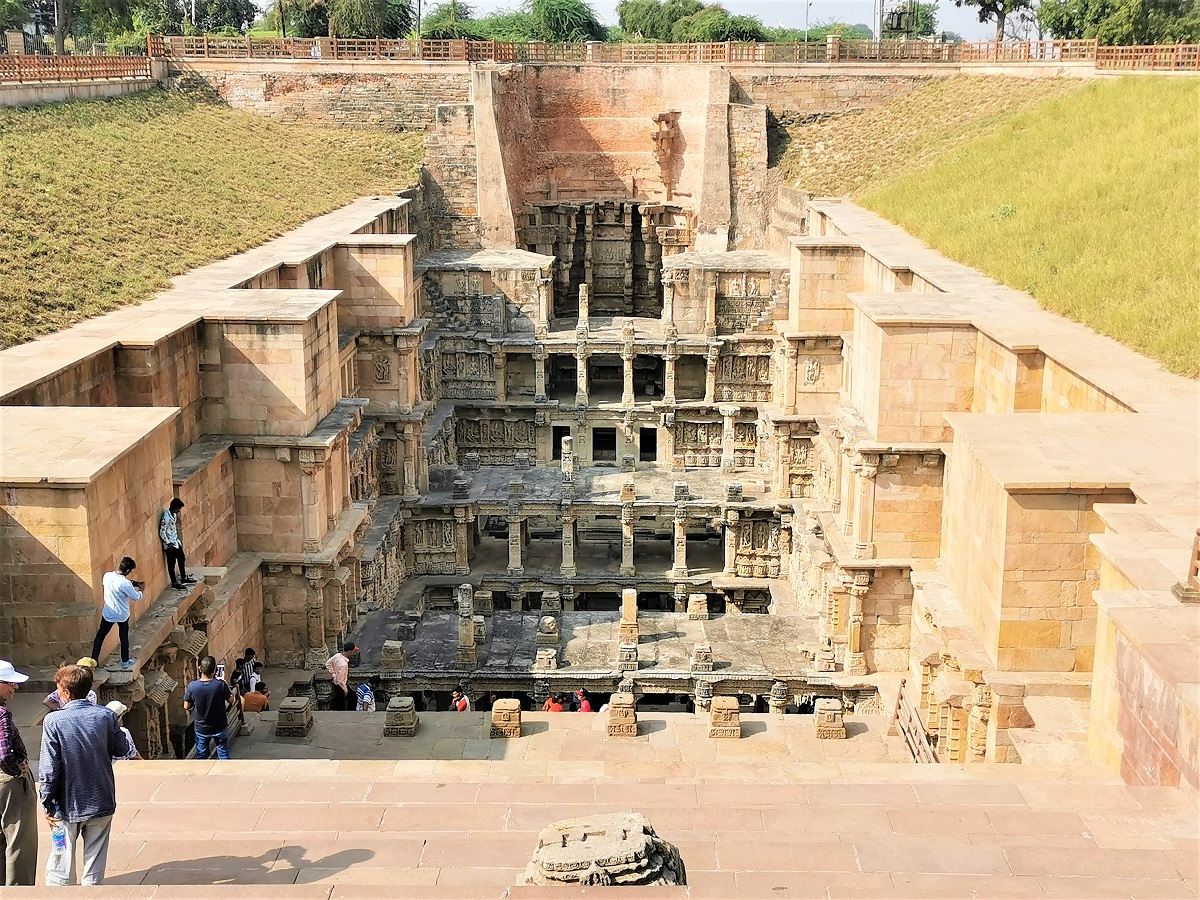The Ranns, deserts, artisan villages, stepwells of Gujarat, and much more… in 9 stories… this is ‘story 1’
Co-authored & edited by my travel companion – Shoba Nayar
Where is Gujarat – India?


But…. before we left Chennai!!
Story 1:
Rani-ki-Vav (The Queen’s Stepwell)
Arrival in Gujarat – day 1
Arriving in Ahmedabad airport on a clear balmy evening, my travelling companion Shoba and I marvelled at the wide clean streets as our driver took us to our comfortable hotel on the other side of the city.
A little background on Ahmedabad
Ahmedabad, situated on the Subarmati River, is the largest city in Gujarat in Western India, with a population of around 6 million people. In contrast to the wide modern streets, the old city is a tangle of narrow streets with clusters of interconnecting houses sporting ornate carved wooden doors and facades—testament to the cultures long since passed but where artisan wood workers were revered for their craft. Exploring Ahmedabad would have to wait – that would come in the middle of this exciting travelling extravaganza of the region over the next 10 days. Our itinerary was pretty packed and we were excited to get underway early the next morning.
Patan & the Queen’s Stepwell
Setting out the following morning, our first destination was the city of Patan 140km towards the north. Here we would be mesmerised by the most fascinating of UNESCO* world heritage sites. Until you visit a ‘stepwell’, you cannot imagine how amazing these architechtural wonders can be!
*UNESCO: United Nations Educational, Scientific and Cultural Organization
Set in a tranquil green park of well tended gardens and neem trees on the banks of the Saraswati River, the 7 storied stepwell has a fascinating history. As you approach, all you see is a low stone wall above ground; but, when you get to the entrance, be prepared to be wowed by the beauty of this ancient and magnificant stone structure.
The setting & history of the stepwell
Set below ground, it is one of the largest and finest stepwells ever constructed. Comisioned in 1063 by Queen Udayamati as a memorial to her Hindu King, this stepwell, Rani-ki-Vav (The Queen’s Stepwell), took over 20 years to build in the 11th century AD (900 years ago). From its circular well deep in the lower level recesses it had the practical function of providing water, along with cool sleeping conditions, for the merchants. This water was essential for the caravans on this trading route through India. Built in the Maru-Gujaru architectural style these stepwells usually begin as a pit of water in the sandy desert but, as the stepwell is developed, they become a masterpiece of crafted detail and great beauty.
Construction & architecture
Built in a style that represented the sanctity of water in the form of an inverted temple construction, the craftsmen were also working at a time where temples, palaces, and places of notoriety were being constructed with great complexity and ornamentation. The art within the ‘Queen’s Stepwell’ arises out of more than 500 principle and over 1000 minor sculptures representing all that is in the universe. This stepwell construction is formed by the 7 stories of pillars, steps, and highly artistic panels, many of which are still in good condition despite the searing heat and wind blown sand which blasts the ancient stone. Some parts have been damaged by salt and sand, or destroyed during archeological restoration.
Modern discovery & restoration
After being buried for centuries under tons of silt, the stepwell was re-discovered in the 1940s. It was restored over 6 years in the 1980s gaining UNESCO heritage status in 2014. The multitude of intricate carvings represent mythology, religion, and secular society. The asthetic beauty depicts a quality that must have been very ‘alive’ during the heyday of this much loved and constantly used water well. Part of the genius of this stepwell construction was the ancient technuiqes commonly used during this century where the blocks of stone were placed in a way that ‘holds together’ the whole structure.


Looking into where the ‘well’ is


Missing its pavilions, the structure cannot operate now as it did in the 11th and 12th centuries due to the reliance on subterranean water supply and the change to the Saraswati river bed following tectonic activity in the 13th century which caused silting and flooding, burying the complex for several centuries. To give you an idea of its proportions, it is 92ft (28m) deep, 213ft (65m) long and 66ft (20m) wide. The circular water tank is 31ft (9.5m) deep and the whole complex contains 212 pillars.


Intricate carved dieties and everyday life depictions


Patola weaving
Leaving this delightful scene we visited the Patola weaving family and artisans of Mashru to learn about the ancient art of preparing the silk to make garments. The silk, which comes from China, is processed by segmentally dyeing the double Ikat (8 threads) with mathematial precision. We were shown the process for perfecting this technique with knotting and using natural vegetable dyes.
When the cotton or silk is put on the loom to be woven into a very fine shawl, or other garment, it develops a self pattern on both sides of the material that lasts for hundreds of years. We were given a tour of the ‘factory and museum’ before watching one of the family men working at the loom. This is the only ‘factory’ carrying out this unique style and fascinating art of cloth making. One sari takes 5 people about 5-6 months to create and costs about $USD3000.


Upstairs in the same building, another family member was carrying out the intricate artisan work of ‘paper cutting’. Many of these works were framed for purchase.
Leaving Patan for Modhera Sun Temple
Soon we were driving past crops of cotton and castor oil plants neatly sitting side by side creating patterns on the landscape and stretching as far as the eye could see. These crops are a major industry in Gujarat and we became very familiar with this farming scene as we travelled through the State.
Story 2… ‘Modhera Sun Temple’ coming soon.
Travel organised with Suresh Bahuguna at Lotus India Journeys!
http://lotusindiajourneys.com/index.php
#gujarat, #gujarattravel, #lettheadventurebegin, #travel, #traveltheworld, #worldtraveler, #ahemdabad #surat #baroda #junagadh #gondal #gujjus #kathiyawadi #kutch #bhavnagar #jamnagar #gujratphotography #gujarati, #inspirational, #ahmedabad_instagram, #gujjuthings, #gujju, #teresaglobaltravels, #theglobewanderer, #teresatraveller, #traveltheglobe,













The sharp images of wonderful locations. Very informative commentaries provides an on-site visiting experience of many places where yesterday meets today in a perfect harmony.
You have done a great job by wel mixing your carefully chosen, out of the way hystorical landmarks and well comprehending many glorious ancient heritages and traditions of a mystical land.
This far exceedes normal reading expectations. I enjoyed every bits therein as a learning experience with deeper understandings.
Dear Mahesh, you are very kind and as always, your words are poetry…. thankyou again and again… the next in this series is underway and I look forward to sharing our journey with you… kind regards again – Teresa
They don’t build like this anymore……………..
Thankyou Manfred – yes that time has passed.
Thank you for showing us such an amazing place. Your description brings the place to life through space and time. Precious observations 🙂
Thankyou Leonetta, that is a great observation and one that I love to hear. I love ‘taking people on a journey’ …. and the next story is about to be published (#5) with #6 {of 9 in this series} is well underway!!